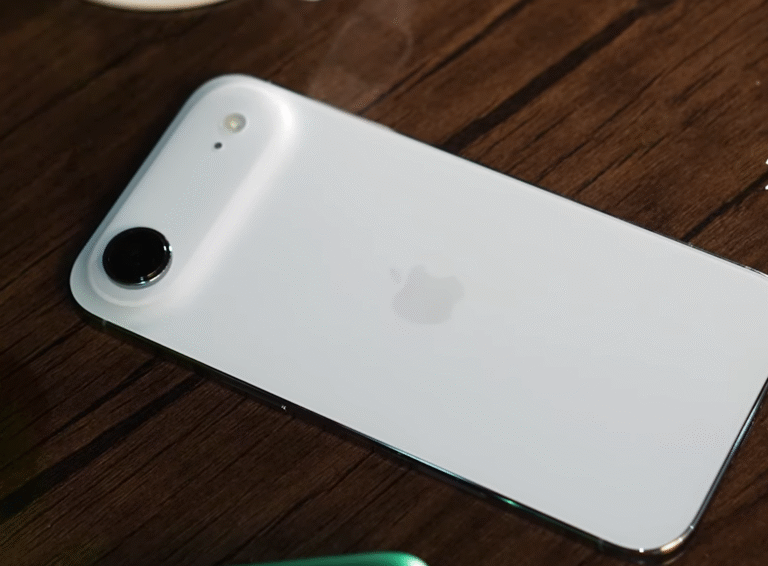Foldable phones have been around for a few years now, carving out their own premium niche. Samsung led the way, others followed, and now we’re on the brink of a folding iPhone. That looming Apple moment is bound to shake things up again.
But Google’s approach is fascinating because the Pixel identity and the foldable identity don’t line up perfectly. The Pixel line has always focused on smart software, clean design, and excellent everyday value — not on being the most powerful or luxurious device. Meanwhile, foldables have always lived in the high-end space: experimental, expensive, and meant for people who want everything in one phone.
This contrast sets the stage for the Pixel 10 Pro Fold. It’s not just another Pixel, and it’s not trying to be a Galaxy Z Fold clone either. It lives in its own lane — and that’s what makes it both exciting and complicated.
A Hinge Worth Talking About
The most noticeable change this year is the completely re-engineered hinge. Gone is the gear mechanism; in its place is a compact, gearless design that makes the whole phone feel more refined.
The outer bezel is thinner, the hinge motion is smoother, and there’s a satisfying resistance when opening and closing the device. It’s the kind of small engineering detail that you might not appreciate on day one but grows on you over time.
And here’s something that doesn’t show up in spec sheets: that hinge is largely responsible for two major upgrades — better battery capacity and full IP68 water and dust resistance. By shrinking the hinge, Google made space for a bigger battery and improved sealing. That’s not marketing fluff; it’s clever design execution.
Brighter Displays, Familiar Layout
The outer cover screen is now 6.4 inches and much brighter than before. With a peak brightness around 3000 nits, it’s easily visible even in direct sunlight. Open it up, and the 8-inch inner display gets a similar brightness boost, which makes multitasking or watching content far more pleasant than last year’s model.
The bezels remain on the medium side, and yes, the crease is still there — visible and tactile. But like most foldables, it fades into the background after a few days of use. This isn’t a radical redesign, but it’s an essential refinement.
Pixelsnap: The Unexpected Hero Feature
One of the smartest additions this year is Pixelsnap. Google added Qi2 magnets to the back of every Pixel 10, including the Fold, which lets it snap perfectly to MagSafe accessories. Whether it’s a charger, a dock, or a car mount, the Pixel 10 Pro Fold sticks like it belongs there.
It’s a subtle but powerful move. For the first time, Pixel owners can tap into the vast MagSafe ecosystem without workarounds. Even with the Fold’s heavier build, it stays firmly mounted on a car dashboard. That’s the kind of real-world convenience that specs don’t convey.
Battery Life: Quietly Impressive
Inside the Pixel 10 Pro Fold is a 5,015 mAh battery, and thanks to the thinner hinge and efficient use of space, battery life has quietly become one of this device’s strengths.
Using it mostly closed — like a regular phone — easily delivers around six hours of screen-on time. When unfolded for extended periods, battery life drops faster, as expected, but still holds up respectably.
The Tensor G5 chip isn’t a performance monster, but its efficiency paired with smart software optimization gives this foldable endurance that many didn’t expect. It’s not a fast-charging champion, but it’s steady and reliable.
Real-World Productivity: A Pixel Specialty
Where this phone shines is productivity. Folding it open creates a different mindset — suddenly, you’re planning trips, managing calendars, and working through emails side by side. Android’s split-screen and taskbar aren’t new, but on this display, they feel purposeful.
It’s not about gimmicks; it’s about quietly nudging you to do more. In daily use, the transition between folded and unfolded feels smoother than many rivals. That’s Google’s software magic at work.
Cameras and Hardware: A Step Behind
If you’re expecting groundbreaking hardware, this isn’t it. The camera setup is essentially unchanged from last year — very good, almost flagship-grade, but not quite Pixel 10 Pro flagship. Photos are sharp and well-processed, but low-light detail and selfie performance lag behind the best.
The Tensor G5 chip is smooth for everyday use but falls short against the Snapdragon 8 Elite series in raw performance. Gamers and power users will feel that gap, especially at this price point.
And yes, this is still a chunky foldable. The weight and thickness are noticeable when closed. Compared to newer, ultra-thin foldables from Chinese brands, it feels more substantial in the hand — some might call it premium, others might call it bulky.
Unique Perspective: Google’s Quiet Long Game
Here’s where Google might be playing a different game entirely. While competitors are chasing thinness, Google seems to be perfecting fundamentals: hinge design, battery endurance, accessory compatibility, and everyday usability.
It’s almost as if Google isn’t trying to win the spec sheet battle — it’s trying to make foldables feel normal. The Pixel 10 Pro Fold doesn’t scream for attention. It blends into your life like a regular Pixel, just with a super-power hidden inside.
That approach might not win over the hardcore spec chasers today, but it could quietly shape the foldable market tomorrow.
Verdict: Smart, Thoughtful, Not for Everyone
The Pixel 10 Pro Fold is a fascinating device. It’s the smartest foldable Google has made — maybe the smartest foldable, period — but it’s not for everyone. At $2,000, people expect bleeding-edge everything. This phone doesn’t give you that.
What it does give you is refined software, a brilliant hinge, impressive battery life, MagSafe compatibility, and the classic Pixel experience, all in a foldable form.
For a small but growing group of users, that might be exactly what they’ve been waiting for.



